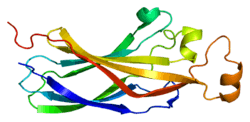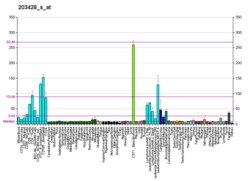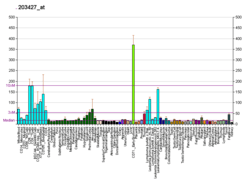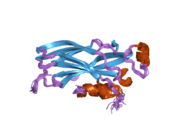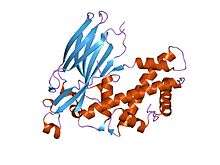ASF1A
Histone chaperone ASF1A is a protein that in humans is encoded by the ASF1A gene.[3][4][5]
Function
This gene encodes a member of the H3/H4 family of histone chaperone proteins and is similar to the anti-silencing function-1 gene in yeast. The protein is a key component of a histone donor complex that functions in nucleosome assembly. It interacts with histones H3 and H4, and functions together with a chromatin assembly factor during DNA replication and repair.[5]
Interactions
ASF1A has been shown to interact with TLK1,[6][7] TLK2,[6] CHAF1B[8] and CHAF1A.[8]
References
- ↑ "Human PubMed Reference:".
- ↑ "Mouse PubMed Reference:".
- ↑ Lai CH, Chou CY, Ch'ang LY, Liu CS, Lin W (May 2000). "Identification of novel human genes evolutionarily conserved in Caenorhabditis elegans by comparative proteomics". Genome Research. 10 (5): 703–13. PMC 310876
 . PMID 10810093. doi:10.1101/gr.10.5.703.
. PMID 10810093. doi:10.1101/gr.10.5.703. - ↑ Zhang QH, Ye M, Wu XY, Ren SX, Zhao M, Zhao CJ, Fu G, Shen Y, Fan HY, Lu G, Zhong M, Xu XR, Han ZG, Zhang JW, Tao J, Huang QH, Zhou J, Hu GX, Gu J, Chen SJ, Chen Z (Oct 2000). "Cloning and functional analysis of cDNAs with open reading frames for 300 previously undefined genes expressed in CD34+ hematopoietic stem/progenitor cells". Genome Research. 10 (10): 1546–60. PMC 310934
 . PMID 11042152. doi:10.1101/gr.140200.
. PMID 11042152. doi:10.1101/gr.140200. - 1 2 "Entrez Gene: ASF1A ASF1 anti-silencing function 1 homolog A (S. cerevisiae)".
- 1 2 Silljé HH, Nigg EA (Jul 2001). "Identification of human Asf1 chromatin assembly factors as substrates of Tousled-like kinases". Current Biology. 11 (13): 1068–73. PMID 11470414. doi:10.1016/S0960-9822(01)00298-6.
- ↑ Rual JF, Venkatesan K, Hao T, Hirozane-Kishikawa T, Dricot A, Li N, Berriz GF, Gibbons FD, Dreze M, Ayivi-Guedehoussou N, Klitgord N, Simon C, Boxem M, Milstein S, Rosenberg J, Goldberg DS, Zhang LV, Wong SL, Franklin G, Li S, Albala JS, Lim J, Fraughton C, Llamosas E, Cevik S, Bex C, Lamesch P, Sikorski RS, Vandenhaute J, Zoghbi HY, Smolyar A, Bosak S, Sequerra R, Doucette-Stamm L, Cusick ME, Hill DE, Roth FP, Vidal M (Oct 2005). "Towards a proteome-scale map of the human protein-protein interaction network". Nature. 437 (7062): 1173–8. PMID 16189514. doi:10.1038/nature04209.
- 1 2 Mello JA, Silljé HH, Roche DM, Kirschner DB, Nigg EA, Almouzni G (Apr 2002). "Human Asf1 and CAF-1 interact and synergize in a repair-coupled nucleosome assembly pathway". EMBO Reports. 3 (4): 329–34. PMC 1084056
 . PMID 11897662. doi:10.1093/embo-reports/kvf068.
. PMID 11897662. doi:10.1093/embo-reports/kvf068.
External links
- Human ASF1A genome location and ASF1A gene details page in the UCSC Genome Browser.
Further reading
- Munakata T, Adachi N, Yokoyama N, Kuzuhara T, Horikoshi M (Mar 2000). "A human homologue of yeast anti-silencing factor has histone chaperone activity". Genes to Cells. 5 (3): 221–33. PMID 10759893. doi:10.1046/j.1365-2443.2000.00319.x.
- Wiemann S, Weil B, Wellenreuther R, Gassenhuber J, Glassl S, Ansorge W, Böcher M, Blöcker H, Bauersachs S, Blum H, Lauber J, Düsterhöft A, Beyer A, Köhrer K, Strack N, Mewes HW, Ottenwälder B, Obermaier B, Tampe J, Heubner D, Wambutt R, Korn B, Klein M, Poustka A (Mar 2001). "Toward a catalog of human genes and proteins: sequencing and analysis of 500 novel complete protein coding human cDNAs". Genome Research. 11 (3): 422–35. PMC 311072
 . PMID 11230166. doi:10.1101/gr.GR1547R.
. PMID 11230166. doi:10.1101/gr.GR1547R. - Silljé HH, Nigg EA (Jul 2001). "Identification of human Asf1 chromatin assembly factors as substrates of Tousled-like kinases". Current Biology. 11 (13): 1068–73. PMID 11470414. doi:10.1016/S0960-9822(01)00298-6.
- Mello JA, Silljé HH, Roche DM, Kirschner DB, Nigg EA, Almouzni G (Apr 2002). "Human Asf1 and CAF-1 interact and synergize in a repair-coupled nucleosome assembly pathway". EMBO Reports. 3 (4): 329–34. PMC 1084056
 . PMID 11897662. doi:10.1093/embo-reports/kvf068.
. PMID 11897662. doi:10.1093/embo-reports/kvf068. - Chimura T, Kuzuhara T, Horikoshi M (Jul 2002). "Identification and characterization of CIA/ASF1 as an interactor of bromodomains associated with TFIID". Proceedings of the National Academy of Sciences of the United States of America. 99 (14): 9334–9. PMC 123141
 . PMID 12093919. doi:10.1073/pnas.142627899.
. PMID 12093919. doi:10.1073/pnas.142627899. - Umehara T, Horikoshi M (Sep 2003). "Transcription initiation factor IID-interactive histone chaperone CIA-II implicated in mammalian spermatogenesis". The Journal of Biological Chemistry. 278 (37): 35660–7. PMID 12842904. doi:10.1074/jbc.M303549200.
- Tagami H, Ray-Gallet D, Almouzni G, Nakatani Y (Jan 2004). "Histone H3.1 and H3.3 complexes mediate nucleosome assembly pathways dependent or independent of DNA synthesis". Cell. 116 (1): 51–61. PMID 14718166. doi:10.1016/S0092-8674(03)01064-X.
- Mousson F, Couprie J, Thuret JY, Neumann JM, Mann C, Ochsenbein F (Jul 2004). "1H, 13C and 15N resonance assignments of the conserved core of hAsf1 A". Journal of Biomolecular NMR. 29 (3): 413–4. PMID 15213445. doi:10.1023/B:JNMR.0000032497.24661.44.
- Zhang R, Poustovoitov MV, Ye X, Santos HA, Chen W, Daganzo SM, Erzberger JP, Serebriiskii IG, Canutescu AA, Dunbrack RL, Pehrson JR, Berger JM, Kaufman PD, Adams PD (Jan 2005). "Formation of MacroH2A-containing senescence-associated heterochromatin foci and senescence driven by ASF1a and HIRA". Developmental Cell. 8 (1): 19–30. PMID 15621527. doi:10.1016/j.devcel.2004.10.019.
- Groth A, Ray-Gallet D, Quivy JP, Lukas J, Bartek J, Almouzni G (Jan 2005). "Human Asf1 regulates the flow of S phase histones during replicational stress". Molecular Cell. 17 (2): 301–11. PMID 15664198. doi:10.1016/j.molcel.2004.12.018.
- Mousson F, Lautrette A, Thuret JY, Agez M, Courbeyrette R, Amigues B, Becker E, Neumann JM, Guerois R, Mann C, Ochsenbein F (Apr 2005). "Structural basis for the interaction of Asf1 with histone H3 and its functional implications". Proceedings of the National Academy of Sciences of the United States of America. 102 (17): 5975–80. PMC 1087920
 . PMID 15840725. doi:10.1073/pnas.0500149102.
. PMID 15840725. doi:10.1073/pnas.0500149102. - Tang Y, Poustovoitov MV, Zhao K, Garfinkel M, Canutescu A, Dunbrack R, Adams PD, Marmorstein R (Oct 2006). "Structure of a human ASF1a-HIRA complex and insights into specificity of histone chaperone complex assembly". Nature Structural & Molecular Biology. 13 (10): 921–9. PMC 2933817
 . PMID 16980972. doi:10.1038/nsmb1147.
. PMID 16980972. doi:10.1038/nsmb1147. - Sen SP, De Benedetti A (2006). "TLK1B promotes repair of UV-damaged DNA through chromatin remodeling by Asf1". BMC Molecular Biology. 7: 37. PMC 1626478
 . PMID 17054786. doi:10.1186/1471-2199-7-37.
. PMID 17054786. doi:10.1186/1471-2199-7-37. - Agez M, Chen J, Guerois R, van Heijenoort C, Thuret JY, Mann C, Ochsenbein F (Feb 2007). "Structure of the histone chaperone ASF1 bound to the histone H3 C-terminal helix and functional insights". Structure. 15 (2): 191–9. PMID 17292837. doi:10.1016/j.str.2007.01.002.
- Natsume R, Eitoku M, Akai Y, Sano N, Horikoshi M, Senda T (Mar 2007). "Structure and function of the histone chaperone CIA/ASF1 complexed with histones H3 and H4". Nature. 446 (7133): 338–41. PMID 17293877. doi:10.1038/nature05613.
This article is issued from
Wikipedia.
The text is licensed under Creative Commons - Attribution - Sharealike.
Additional terms may apply for the media files.
